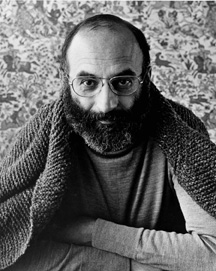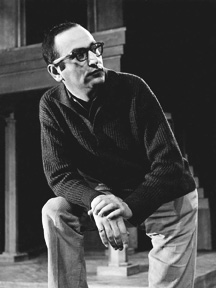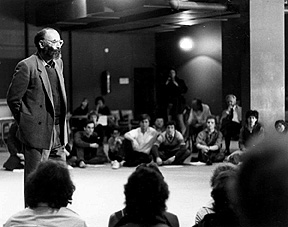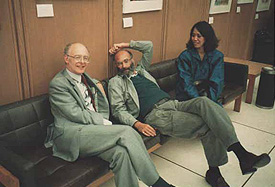
Photo: Canadian Theatre Encyclopedia
John Hirsch was born in Siófok Hungary in 1930 and died in Toronto in 1989. His family lived in Endrod (today GyomaEndrod). His parents and brother died in the Holocaust. Hirsch, then 14, was hidden from the Nazis by a maid who took him to the Budapest Ghetto.
John Hirsch’s theatrical impulses start early. After the war, he was in a UNRRA (refugee) camp in Aschau, Germany (1946). Together with his childhood friend, Marianne Bolgar (d. May 13, 2001, in Montreal), they produced The Snow Queen for the refugee children in the camp. Then in early 1947, with the help of the Zionist underground, John was to sail to Israel with other young people on the Exodus. However, while on the train to Marseilles, he changed his mind and went to Paris. “Neither the pioneering life …nor Judaism sounded like safe bets – or particularly attractive ones” say Fraidie Martz and Andrew Wilson in their 2011 A Fiery Soul. The Life and Theatrical Times of John Hirsch, p.50. He wondered around Paris and eventually found a place for himself in an orphanage outside of Paris. John himself described what then happened this way:
“Every week I would go to a different embassy and ask whether they could use a sixteen year old Hungarian-Jewish orphan, and I put down my name on all the lists there were. Every time you applied for a visa to a country you had to undergo a medical examination, and they always took your blood….I discovered I was too young to emigrate to Brazil; Argentina was interested only in lumberjacks; Mexico needed dental technicians; the United States rejected me because I was underweight.” [Harry Gutkin, Journey into our Heritage. 1980, p. 244-45.]
 He finally manages to be accepted as one of a number of Jewish orphans that the Canadian Jewish Congress was looking to bring to Canada. When asked by them where in Canada he wanted to go to he asked for a map and picked Winnipeg as being in the centre of the continent and thus perhaps safe, remembering his mother’s injunction to avoid extremes.
He finally manages to be accepted as one of a number of Jewish orphans that the Canadian Jewish Congress was looking to bring to Canada. When asked by them where in Canada he wanted to go to he asked for a map and picked Winnipeg as being in the centre of the continent and thus perhaps safe, remembering his mother’s injunction to avoid extremes.
He arrived in Winnipeg, Manitoba, in 1947, studied at the University of Manitoba and formed a children’s company. In 1957, he co-founded, with Tom Hendry , Theatre 77 which, in 1958, joined with Winnipeg Little Theatre to become the country’s first regional theatre, Manitoba Theatre Centre . Mr. Hirsch was the company’s first artistic director.
He made his Stratford Festival debut, invited by Michael Langham, with The Cherry Orchard. He was associate director of the company from 1967-69 and head of CBC television drama from 1974-78.
His love-hate relationship with Stratford, its critics and audience reached a culmination point in 1980. After some disastrous shenanigans involving Stratford’s board of directors and their choices for a new artistic director, Hirsch was invited to be the company’s sole artistic director from 1981-85.

He directed at the National Arts Centre, Toronto Arts Productions, Young People’s Theatre, the Shaw Festival as well as at Stratford (where his 1976 production of Chekhov’s Three Sisters starring Marti Maraden, Martha Henry and Maggie Smith was breathtaking).

He had also directed in the United States, winning an Obie, Outer Critics’ and Los Angeles Drama Critics’ Awards for his productions.
He was awarded the Order of Canada in 1967. He was one of the first high-profile Canadian artists to die of AIDS.
Mr. Hirsch’s directing style was highly imaginative while also being text-driven. Though he often confronted the audience and the purists with his interpretations of a work’s subtext (not to mention his prickly temperament), he was also always prepared to defend his choices.
Most of the above text is from the Canadian Theatre Encyclopedia but it has been corrected and updated in August 2013 at the request of John Hirsch’s cousin, Anna Fried of Halifax. The corrections relate to John’s leaving Hungary via France after the war and how he came to Canada. They are based on the two books referenced in the text. We thank Anna for drawing our attention to the incorrect information.
We thank the Stratford Festival Canada for the use of the above photographs.
The two photographs below are from the collection of Judy Young Drache.

John Hirsch with Bill Valgardson and Alexina Louie at the National Library in 1985.

Left to right: Bill Valgardson, Marco Micone, John Hirsch, Alexina Louie and Neil Bissoondath before a panel discussion on the role of artists in culturally diverse societies, National Library of Canada, 1985.
